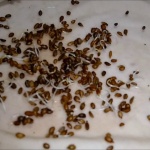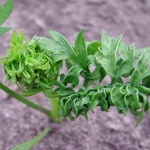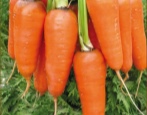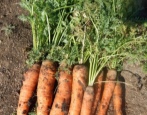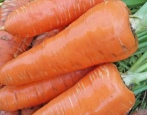
- Name synonyms: Abaco
- Year of approval: 2009
- Appointment: for fresh consumption, for canning, for freezing, for bundled products, for making juice
- Leaf rosette shape: semi-spreading
- Leaves: long, dark green, finely split
- Weight, g: 105-220
- The form : conical with blunt tip
- Taste qualities: good and excellent
- Composition : dry matter 9.4-12.4%, total sugar 5.2-8.4%, carotene up to 18.6 mg per 100 g of raw matter
- Ripening terms: early
Carrots are a healthy vegetable, so they are grown by all gardeners, summer residents and farmers without exception. They give preference to fruitful varieties that are easy to care for, quickly adapt to growing conditions, and also have excellent taste. These characteristics are endowed with an early maturing hybrid of Abaco of Dutch selection.
Description of the variety
The Abaco carrot is a hybrid of the first generation, bred by scientists from the Monsanto agricultural firm (Netherlands) in 2005. Vegetable crop entered the register in 2009. Carrots are recommended for cultivation in the Central Region, but today they are cultivated in different climatic zones. The vegetable is grown both in garden ridges and in the fields.
Characteristics of the appearance of the plant and root crops
Dutch carrot Abaco is a plant with a powerful rosette and semi-spreading leaves. The height of the tops reaches 50-60 cm. The color of the leaves is dark green, and the edges are finely dissected. A characteristic feature is that the foliage does not wither, does not fall off, rarely turns yellow. The tops have no pronounced aroma. The hybrid belongs to the Chantenay cultivar.
Abaco represents a group of medium-fruited varieties. Roots ripen neat, so the hybrid is often grown commercially. Fruit weight varies from 105 to 220 grams. The length of the roots is 14-16 cm, and the diameter of the vegetable is about 5 cm. The shape of the carrot is conical, with a rounded nose. The ripe fruit is evenly covered with an intense dark orange color. The peel (bark) is thin, smooth, with a noticeable shine and a few filamentous roots.
The dug carrots can be transported over long distances, as well as stored for a long time. The variety is ideal for storage throughout the winter. During storage, carrot specimens do not crack, do not deform. Collection is allowed by mechanical and manual methods.
Purpose and taste of tubers
Abaco carrots are remembered for their great taste. The dark orange flesh is characterized by a fleshy, tender, crunchy and juicy structure without fibrillation. The taste is expressed by sweetness, intertwined with sugar content and carrot aroma. The core is thin, does not differ in color from the pulp at all. Overripe root vegetables may have an enlarged pith. It is also worth noting that the pulp contains an increased amount of sugars, carotene and trace elements.
The harvested root vegetables are eaten fresh, added to cold and hot dishes, frozen, processed into juice, and also used for canning vegetable salads.
Maturation
Dutch carrots belong to the early ripening group. The growing season lasts 90-95 days. The fruits ripen together. Digging a vegetable is carried out simultaneously, not gradually, as soon as the roots acquire the appropriate color and gain the required mass.It is easy to check the maturity of vegetables: just pull out a couple of fruits. As a rule, the harvest takes place in August and the first half of September.
Yield
The hybrid is claimed to be a high-yielding hybrid. From 1 hectare of plantings, you can dig up 420-560 centners of juicy carrots. The maximum yield is recorded at around 1160 c / ha.
Growing and care
A vegetable crop is cultivated through sowing seeds. For this, a site is selected in advance where shallow grooves (2-4 cm) are made, which must be moistened. The distance between the rows should be 15-20 cm. Planting is carried out according to the scheme 5-7x15 cm. Cabbage, tomatoes, early potatoes, onions and cucumbers are considered the best predecessors.
Despite the fact that carrot seedlings are able to withstand temperature drops to -3-4 degrees, the vegetable should be planted after the soil and air warms up to + 7-8, when there is no threat of spring frosts returning. Sowing works are carried out from the last week of April to the beginning of May.
You can plant carrots before winter, in late September - early October. To do this, after sowing the seeds, sprinkling of the beds is carried out - mulching, and in the spring, when mass germination occurs, the sprouts are covered with a film, which will protect them from frost. Such actions contribute to the earlier ripening of vegetables - 1-2 weeks earlier.
The Dutch hybrid does not require complex care, however, basic agrotechnical recommendations must be followed. The plant needs watering with settled water every 10-12 days (stop 2 weeks before harvesting), root dressing (2-3 times per season, alternating fertilizers), loosening and weeding of the soil (5-6 times a month), two-stage thinning while maintaining the distance between plants up to 4-5 cm, prevention of diseases and pest infestations. A ripe vegetable should look a little out of the ground, so you do not need to rake it completely.
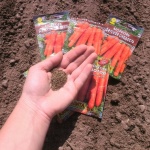
Carrots are one of the most unpretentious crops in terms of growing conditions; they can endure a short drought and a short cold snap. However, to get tasty and large root crops, you should adhere to the basic rules for planting carrots.

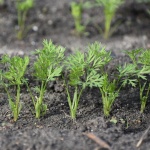
Soil requirements
Planting carrots is carried out in soils of different structure, but it is most comfortable for the vegetable to grow in clay-sandy soil with a high content of the dusty part. In addition, the soil should be light, breathable, fluffy, moist and nutritious, with a low acidity level. The soil should not be swampy and heavy.
Required climatic conditions
Root crops are planted in flat areas, cleared of weeds. Experienced vegetable growers recommend planting in low elevations, where there is a lot of sun, heat and light. It is good if the groundwater flows deeply so that there is no increased dampness and stagnant water.
Disease and pest resistance
Vegetable crops have a good immune system at the genetic level. The vegetable is able to resist leaf blight, as well as a number of other infections. Spreading a small amount of wood ash on the carrot tops and the soil around it will provide reliable protection against attacks of pests. It is extremely rare for carrots to be attacked by a carrot fly and a bear.

Carrots grow in almost any garden.There is an opinion that this culture is very resistant to all kinds of diseases and pests, but this is not the case. Without proper care, carrots become susceptible to all kinds of infections and are affected by harmful insects.


